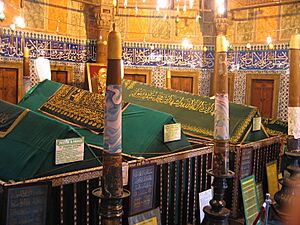Ahmed II facts for kids
Quick facts for kids Ahmed IIاحمد ثانى |
|||||
|---|---|---|---|---|---|
| Amir al-Mu'minin Custodian of the Two Holy Mosques Ottoman Caliph |
|||||
 |
|||||
| Sultan of the Ottoman Empire (Padishah) | |||||
| Reign | 22 June 1691 – 6 February 1695 | ||||
| Predecessor | Suleiman II | ||||
| Successor | Mustafa II | ||||
| Born | 25 February 1643 or 1 August 1642 Constantinople, Ottoman Empire |
||||
| Died | 6 February 1695 (aged 51) Edirne, Ottoman Empire |
||||
| Burial | Süleymaniye Mosque, Istanbul, Turkey | ||||
| Consort | Rabia Sultan Şayeste Hatun |
||||
| Issue | Şehzade Ibrahim Şehzade Selim Asiye Sultan Atike Sultan disputed Hatice Sultan |
||||
|
|||||
| Dynasty | Ottoman | ||||
| Father | Ibrahim | ||||
| Mother | Muazzez Sultan | ||||
| Religion | Sunni Islam | ||||
| Tughra |  |
||||
Ahmed II was the Sultan of the Ottoman Empire from 1691 to 1695. He was born on February 25, 1643, or August 1, 1642, and passed away on February 6, 1695.
Contents
Early Life of Ahmed II
Ahmed II was born to Sultan Ibrahim and Muazzez Sultan. On October 21, 1649, Ahmed and his brothers, Mehmed and Suleiman, had a special ceremony called circumcision.
For almost 43 years, Ahmed was kept in a special part of the palace called the Kafes. This was a place where royal princes lived, often to prevent them from trying to take the throne.

Ahmed II's Time as Sultan
During his time as Sultan, Ahmed II focused mostly on wars against the Habsburgs. He also worked on important issues like taxes and how the government was run.
Important Leaders and Battles
Ahmed II relied heavily on a wise leader named Köprülü Fazıl Mustafa Pasha. This Pasha was from the famous Köprülü family, known for being great leaders and military commanders.
- Fazıl Mustafa Pasha became the Grand Vizier (a top minister) in 1689.
- He removed many corrupt officials and replaced them with loyal people.
- He also improved the tax system to help people affected by wars.
- He made the army stronger by getting more soldiers from different regions.
In October 1690, Fazıl Mustafa Pasha won a big victory. He recaptured Belgrade, a very important fortress. This win gave the Ottomans hope after losing many battles in the 1680s.
However, this success did not last long. On August 19, 1691, Fazıl Mustafa Pasha faced a terrible defeat at the Battle of Slankamen. The Habsburg army, led by Louis William, Margrave of Baden-Baden, won the battle. The Ottomans lost about 20,000 soldiers, including Fazıl Mustafa Pasha himself. This was a huge loss for the Sultan, as he lost his best military leader.
Later Years and Challenges
After Fazıl Mustafa Pasha's death, the Ottoman army faced more defeats.
- In June 1692, the Habsburgs took Oradea, an important Ottoman city.
- In 1694, the Ottomans tried to get Oradea back but failed.
- On January 12, 1695, the fortress of Gyula also fell to the enemy.
With these losses, the Ottoman Empire held only a small part of Hungary. Three weeks later, on February 6, 1695, Ahmed II passed away in Edirne Palace.
Ahmed II's Family
Ahmed II had two known consorts (wives) and several children.
Consorts
- Rabia Sultan: She was Ahmed II's most loved consort. She passed away in 1712.
- Şayeste Hatun: She passed away in 1710.
Sons
Ahmed II had two sons:
- Şehzade Ibrahim: Born in 1692, he became the crown prince in 1703 and passed away in 1714.
- Şehzade Selim: Born in 1692, he was Ibrahim's twin but passed away as a baby in 1693.
Daughters
Ahmed II likely had three daughters:
- Asiye Sultan: Born in 1694, she passed away as a baby in 1695.
- Atike Sultan: Her existence is debated, some historians think she might be Asiye with a different name or a twin.
- Hatice Sultan: She passed away when she was very young.
Ahmed II also cared deeply for his niece, Ümmügülsüm Sultan (daughter of Mehmed IV). He treated her like his own daughter.
See also
 In Spanish: Ahmed II para niños
In Spanish: Ahmed II para niños

